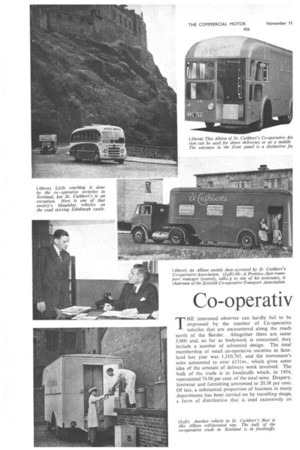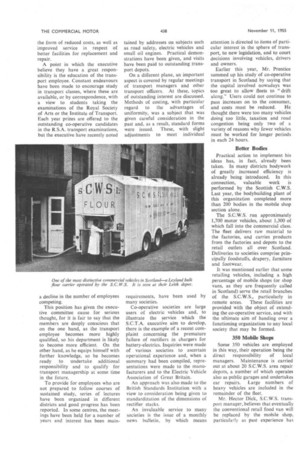Co-operativ nterprise in Scotland
Page 150

Page 151

Page 152

If you've noticed an error in this article please click here to report it so we can fix it.
Over 170 Co-operative Societies North of the Border Run Some 5,000 Vehicles and have Their Own Association
THE interested observer can hardly fail to be impressed by the number of. Co-operative vehicles that are encountered along the roads north of the Border. Altogether there are some 5,000 and, so far as bodywork is concerned, they include a number of advanced design. The total membership of retail co-operative societies in Scotland last year was 1,310,765, and the movement's sales amounted to over intim, which gives some idea of the amount of delivery work involved. The bulk of the trade is in foodstuffs which, in 1954, represented 74.06 per cent. of the total sales. Drapery, footwear and furnishing amounted to 20.38 per cent. Of late, a substantial proportion of business in many departments has been carried on by travelling shops, a form of distribution that is used extensively on
many of the new housing estates.
Altogether, there are 172 retail societies, the largest being St. Cuthbert's Co-operative Association, Edinburgh. The transport manager, Mr. A. Prentice, M.B.E., is also chairman of the Scottish Co-operative Transport Association. The S.C.C.A. membership is nearly 93,000, and the annual sales about £9m. Next in importance is the Glasgow South Society which, in recent years, has embraced several neighbouring units and now has a membership of approximately 82,000, The annual sales of this society are more than Dm. Practically the entire co-operative service in the north of Scotland and the Western Isles is operated by retail branches of the Co-operative Wholesale Society, Ltd.
• The need for cohesion has always been recognized by the co-operative movement and, with three or four exceptions, the societies in Scotland are all members of the Co-operative Union. On the transport side, this cohesion was carried a step further with the establishment, in 1944, of the Scottish Co-operative Transport Association.
The principal objects of this body are to promote, extend and consolidate the transport side of the movement, to provide a medium for mutual help by consultation and exchange of ideas on matters affecting the industry, and to promote or
take part in measures for the protection or improvement of the industry in the interests of the consumer.
The S.C.T. A. are supported by 135 co-operative societies and are governed by an executive committee consisting of representatives appointed by the Co-operative Union Ltd. (Scottish Section), the Scottish Co-operative Wholesale Society, Ltd., and the United Co-operative Baking Society, Ltd., together with one member from each of the 11 Co-operative Union districts into which Scotland is divided.
Since the inception of the Association, the executive have propagated the advantages of standardization. Whilst progress has not been so rapid as had been hoped, a degree of standardization has emerged, bringing advantages in
the form of reduced costs, as well as improved service in respect of better facilities for replacement and repair.
A point in which the executive believe they have a great responsibility is the education of the transport employee. Constant endeavours have been made to encourage study in transport classes, where these are available, or by correspondence, with a view to students taking the examinations of the Royal Society of Arts or the Institute of Transport. Each year prizes are offered to the outstanding co-operative candidates in the R.S.A. transport examinations, but the executive have recently noted a decline in the number of employees competing.
This position has given the executive committee cause for serious thought, for it is fair to say that the members are deeply conscious that on the one hand, as the transport employee becomes more highly qualified, so his department is likely to become more efficient. On the other hand, as he equips himself with further knowledge, so he becomes ready to undertake additional responsibility and to qualify for transport managership at some time in the future.
To provide for employees who are not prepared to follow courses of sustained study, series of lectures have been organized in different districts and good progress has been reported. In some centres, the meetings have been held for a number of years and interest has been main
tamed by addresses on subjects such as road safety, electric vehicles and small oil engines. Practical demonstrations have been given, and visits have been paid to outstanding transport depots.
On a different plane, an important aspect is covered by regular meetings of transport managers and other transport officers. At these, topics of outstanding interest are discussed. Methods of costing, with particular regard to the advantages of uniformity, was a subject that was given careful consideration in the past and, as a result, standard forms were issued. These, with slight adjustments to meet individual requirements, have been used by many societies.
Co-operative societies are large users of electric vehicles and, to illustrate the service which the S.C.T.A. executive aim to develop, there is the example of a recent complaint concerning the premature failure of rectifiers in chargers for battery-electrics. Inquiries were made of various societies to ascertain operational experience and, when a summary had been compiled, representations were made to the manufacturers and to the Electric Vehicle Association of Great Britain.
An approach was also made to the British Standards Institution with a view to consideration being given to standardization of the dimensions of rectifier stacks.
An invaluable service to many societies is the issue of a monthly news bulletin, by which means attention is directed to items of particular interest in the sphere of transport, to new legislation, and to court decisions involving vehicles, drivers and owners.
Earlier this year, Mr. Prentice summed up his study of co-operative transport in Scotland by saying that the capital involved nowadays was too great to allow fleets to "drift along." Users could not continue to pass increases on to the consumer,
and costs must be reduced. He thought there were too many vehicles doing' too little, taxation and road congestion being only two of a variety of reasons why fewer vehicles must be worked for longer periods in each 24 hours.
Better Bodies Practical action to implement his ideas has, in fact, already been taken. In many districts bodywork of greatly increased efficiency is already being introduced. In this connection, valuable work is performed by the Scottish C.W.S. Last year, the bodybuilding plant of this organization completed more than 200 bodies in the mobile shop section alone.
The S.C.W.S. run approximately 1,700 motor vehicles, about 1,300 of which fall into the Commercial class. The fleet delivers raw material to the factories, and carries products from the factories and depots to the retail outlets all over Scotland. Deliveries to societies comprise principally foodstuffs, drapery, furniture and footwear.
It was mentioned earlier that some retailing vehicles, including a high percentage of mobile shops (or shop vans, as they are frequently called in Scotland) serve the retail branches of the S.C.W.S., particularly in remote areas. These facilities are provided with the object of extending the co-operative service, and with the ultimate aim of handing over a functioning organization to any local society that may be formed.
350 Mobile Shops
Some 350 vehicles are employed in this way, their operation being the direct responsibility of local managers. Maintenance is carried out at about 20 S.C.W.S. area repair depots, a number of which operates also as public garages and undertakes car repairs. Large numbers of heavy vehicles are included in the remainder of the fleet.
Mr. Hector Dick, S.C.W.S. transport manager, believes that eventually the conventional retail food van will be replaced by the mobile shop, particularly as past experience has
































































































































































































































































































